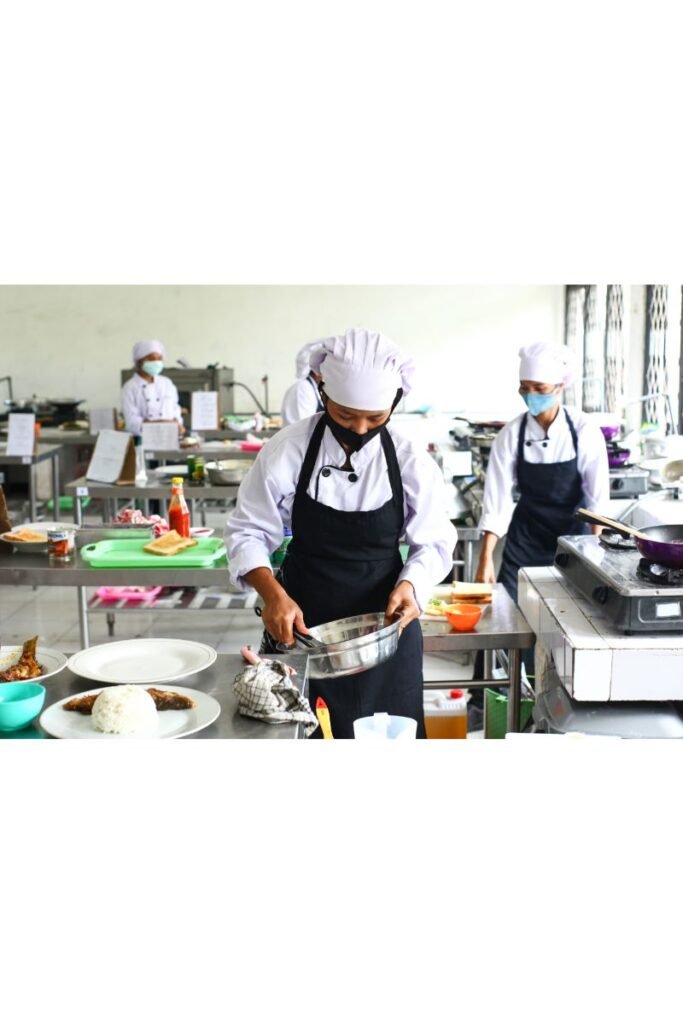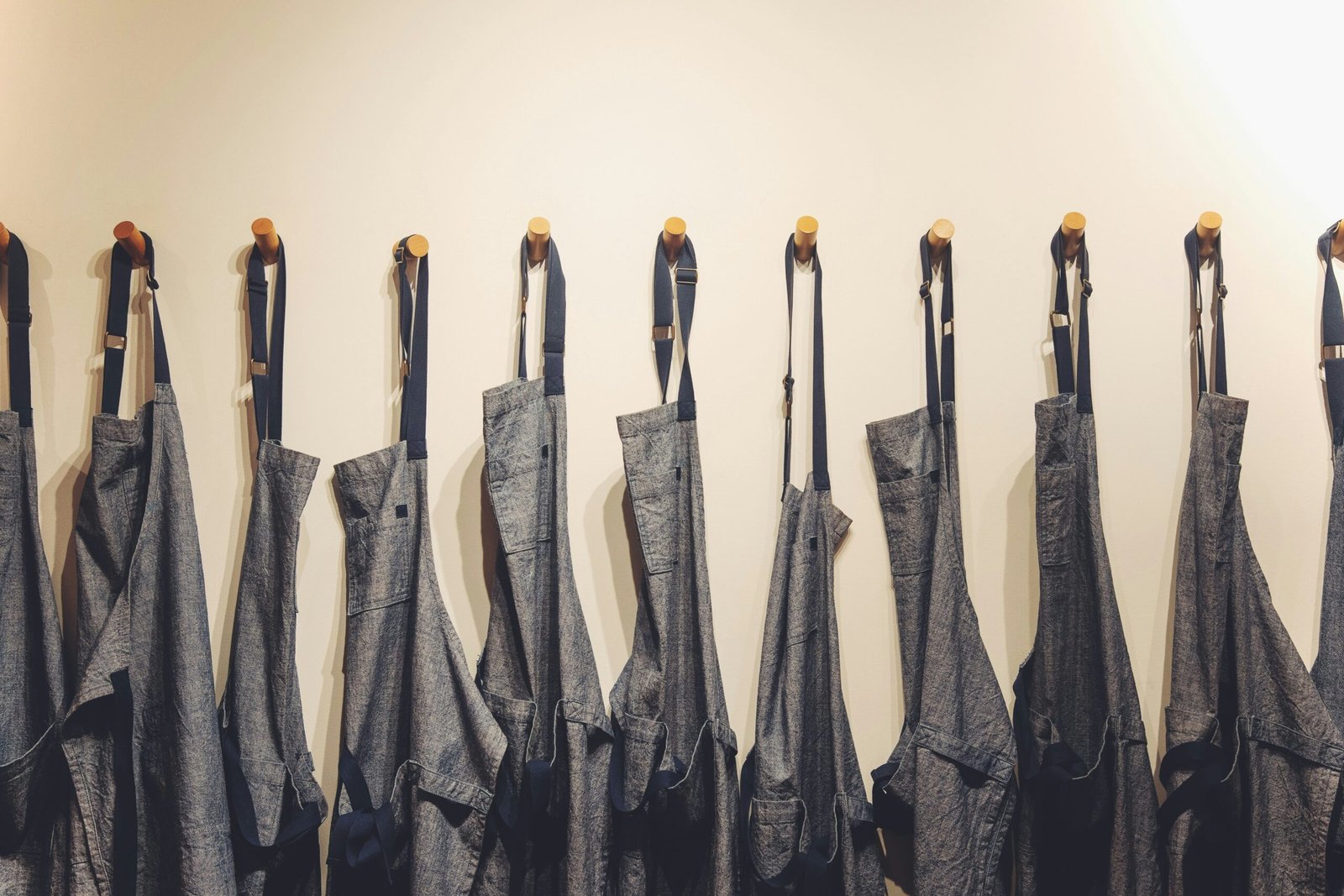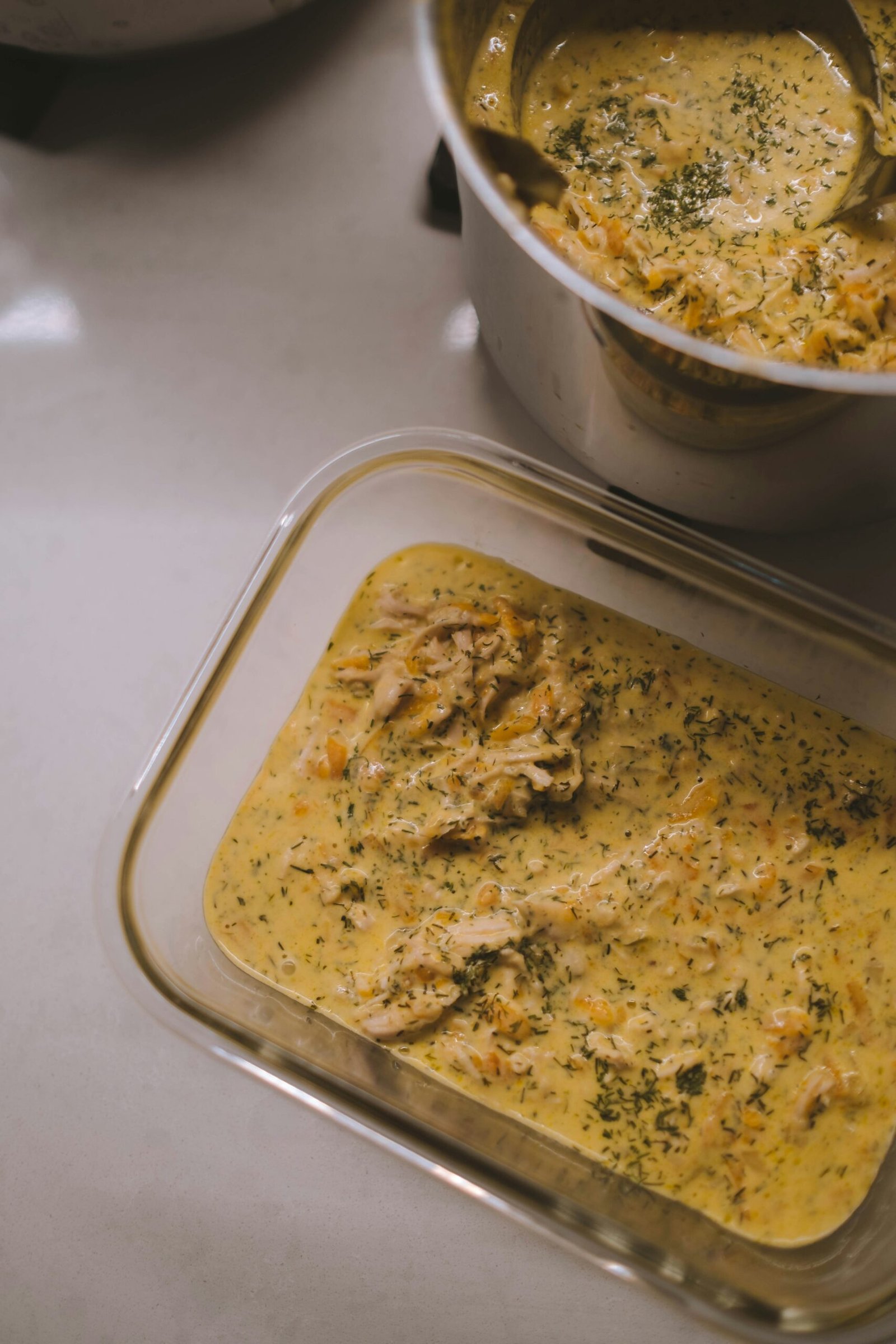Introduction to Cooking with an Apron
An apron is an essential piece of kitchen apparel that has been a mainstay in culinary practices for centuries. Historically, aprons were designed not only to protect clothing from food stains but also to signify one’s role within the kitchen, whether it be a professional chef or a diligent home cook. The use of aprons can be traced back to ancient civilizations where they were utilized in various tasks including cooking, crafting, and even farming. This humble garment has evolved over time, adapting to the changing fashion trends, functionality, and the diverse needs of modern kitchens.
In contemporary cooking, the apron serves multiple purposes. Primarily, it protects the wearer’s clothing from spills, splatters, and other messes that are an inevitable part of the culinary process. This protective layer allows cooks to focus on their crafting without the worry of undoing their outfits with stains. Moreover, many modern aprons come equipped with pockets that serve as handy storage for tools and utensils, thereby improving efficiency while cooking.
The evolution of aprons reflects a significant cultural shift towards home cooking and the culinary arts. Where once they might have been seen as a strictly utilitarian garment, today’s aprons encompass a variety of styles that can complement personal tastes and kitchen decor. From traditional fabric patterns to modern, sleek designs, the apron now represents both functionality and fashion. Wearing an apron can also heighten the experience of cooking; it can evoke a sense of readiness and professionalism that transforms the act of preparing meals into an enjoyable and rewarding activity.
Types of Aprons: Finding the Right Fit
When it comes to cooking, selecting the right apron can greatly enhance both comfort and functionality in the kitchen. Various types of aprons cater to different culinary activities, and understanding these options is essential for every home chef. The three primary types of aprons are waist aprons, bib aprons, and full-length aprons.
Waist aprons, often favored by chefs in commercial kitchens, are designed to cover the waist area and typically feature pockets for tools and utensils. Their minimalist design allows for maximum freedom of movement, making them ideal for quick, casual cooking or food service settings. They are particularly advantageous for tasks that require bending or reaching, as they do not restrict leg movement.
Bib aprons provide coverage for the torso and are secured around the neck and waist, offering superior protection against spills and splashes. The added fabric in the front shields clothing more effectively, which is valuable for both home cooks and professional chefs engaged in messy preparations. Many bib aprons are adjustable, allowing for a tailored fit that accommodates the wearer’s body shape.
Full-length aprons cover the entire front of the body, extending from the chest to the knees. This type is perfect for individuals who anticipate heavy splatter, such as during frying or grilling. Full-length aprons often feature adjustable neck straps and a variety of pocket configurations, which enhance their practicality in the kitchen.
When selecting an apron, consider your cooking habits and the level of protection you require. If you often cook quick meals, a waist apron might suffice. However, for those who frequently experiment with elaborate recipes, investing in a bib or full-length apron could be more beneficial. Ultimately, the right apron will enhance your cooking experience and keep your clothing pristine.
Material Matters: Choosing the Right Fabric
When selecting an apron for your kitchen needs, the fabric choice plays a crucial role in both functionality and comfort. The three most common materials used for aprons are cotton, linen, and polyester. Each fabric type has its unique characteristics that can significantly affect your cooking experience.
Cotton aprons are renowned for their softness and breathability. They provide a high level of comfort, making them ideal for extended wear while cooking. Furthermore, cotton is absorbent, which can be particularly beneficial when dealing with spills. However, while cotton aprons are generally durable, they may require more frequent washing due to stains and can be prone to wrinkling.
Linen offers a charming, rustic aesthetic and is notably strong and durable. While it is less common than cotton, linen’s natural fibers are resistant to dirt and stains, allowing for easier cleaning. Additionally, linen aprons become softer with each wash, contributing to overall comfort. However, the trade-off includes a higher price point and a tendency to wrinkle more than cotton.
On the other hand, polyester aprons present an excellent low-maintenance option. These synthetic fibers are typically stain-resistant and durable, making them suitable for intensive cooking sessions. Polyester aprons often feature vibrant colors and patterns, maintaining their appearance even after numerous washes. However, they may lack the breathability of cotton or linen, which could lead to discomfort during prolonged use.
Ultimately, the choice of fabric should align with your cooking habits and personal preferences. Understanding the pros and cons of cotton, linen, and polyester can help you make an informed decision that enhances your kitchen experience.
Style and Personalization: Expressing Yourself in the Kitchen
.
Cooking is not merely a chore; it is an art that allows for personal expression, and an apron serves as a canvas to reflect your unique style. When selecting an apron, consider the myriad of colors, patterns, and styles available that can represent your personality and contribute to a more enjoyable cooking experience. Whether you lean toward sleek modern designs or prefer whimsical prints, the choice of your apron can enhance the atmosphere of your kitchen.
Color plays a significant role in visual appeal and can evoke emotions that influence your cooking mood. Bright, vibrant colors may energize your cooking routine, while soft pastels can create a more calming environment. Patterns, such as florals or stripes, can add a touch of charm or sophistication, allowing you to convey your tastes effortlessly. As you browse through options, think about how these styles can complement your kitchen decor or make a statement on their own.
For those looking to take personalization a step further, embroidery or DIY projects can provide a distinct flair. Adding your name or initials to an apron not only makes it yours but adds a layer of sophistication that is difficult to achieve with standard options. Furthermore, consider attaching pockets or embellishments that showcase your personality—perhaps a vintage button collection or fabric patches that tell a story. Such creative modifications not only elevate the look of the apron but also make it functional.
Ultimately, an apron is much more than a protective garment; it is an extension of oneself. By thoughtfully selecting and personalizing an apron that resonates with your style, you can create a unique presence in your kitchen that makes cooking a more enjoyable and vibrant experience.
Apron Care: Keeping Your Cooking Gear Clean
Proper care of aprons is crucial to maintaining their functionality and appearance. Different fabrics require specific washing instructions to ensure that the apron remains in good condition. For cotton and cotton-blend aprons, machine washing in cold water is generally safe. However, a gentle cycle is recommended to reduce wear and tear. Polyester or polyurethane-coated aprons may require hand washing or wiping down with a damp cloth to avoid damage. Always refer to the care label for precise instructions to safeguard your cooking gear.
Stain removal is an essential aspect of apron maintenance. Most cooking-related stains can be treated effectively if addressed promptly. For common stains such as oil or food, sprinkle cornstarch or baking soda on the stain to absorb excess grease; leave it for a few minutes and then brush off before washing. For stubborn stains, a pre-treatment with a stain remover or a mixture of vinegar and water can be effective. Allow the treatment to sit for at least 15 minutes before laundering as per the fabric instructions. Avoid using bleach, especially on colored aprons, as this can lead to discoloration.
Storing aprons correctly also contributes to their longevity. After washing and ensuring that they are completely dry, avoid folding them, as creases may become permanent over time. Instead, hang them on a hook or peg to keep them wrinkle-free and ready for use. If space allows, utilizing a dedicated drawer with dividers can keep multiple aprons organized and accessible without the risk of them becoming soiled or tangled.
By following these practical tips for cleaning and maintaining aprons, cooks can ensure that their cooking gear remains both stylish and functional throughout its use.
Aprons for Kids: Involving Children in Cooking
Involving children in cooking activities can be a rewarding experience for both parents and kids, making it essential to ensure safety and cleanliness in the kitchen. One practical solution is the use of kid-sized aprons, which serve multiple purposes. Firstly, aprons protect children’s clothing from spills, stains, and splatters, thus alleviating concerns about messiness. Additionally, they can introduce an element of fun to cooking, as children may feel more involved and excited when wearing their own specially designed aprons.
When selecting an apron for kids, it is crucial to prioritize comfort and safety. Look for aprons that are made from durable yet soft materials to prevent irritation during prolonged wear. Adjustable straps can also ensure a proper fit, allowing the apron to grow with your child. Furthermore, consider designs that include pockets where young chefs can store their cooking tools or ingredients, fostering a sense of ownership in their culinary endeavors. Consideration of colorful and playful patterns can also elevate their interest and willingness to participate in the kitchen activities.
Also read: From OSRs to Black Latex and Beyond, the Complete Guide to Cooking Gloves
Engaging children in cooking tasks not only teaches them essential life skills but also encourages creativity and teamwork. Assigning age-appropriate duties such as washing vegetables, stirring ingredients, or arranging prepared dishes can make learning both enjoyable and practical. This hands-on experience in the kitchen fosters an understanding of nutrition, measurements, and following instructions, critical skills that will serve children well beyond their early years.
By pairing these educational moments with the use of kid-friendly aprons, parents can create a safe and stimulating environment. Encouraging children to explore the culinary world can lay the foundation for lifelong healthy eating habits while simultaneously strengthening family bonds through shared experiences in the kitchen.
The Role of Aprons in Professional Cooking

Aprons
In the realm of professional cooking, the apron serves as an essential component of a chef’s attire. Beyond its functional aspect, a well-chosen apron can reflect the individual style and professionalism of the chef. This garment plays a critical role in ensuring that culinary experts maintain both hygiene and personal safety while executing their craft. Professional chefs often prefer aprons made from durable, heat-resistant materials, which provide protection against the various hazards present in kitchens.
One of the primary functions of a professional apron is to offer a layer of protection against spills, splatters, and hot surfaces. Many aprons are designed with materials that are resistant to heat and stains, making them suitable for the intense environment of a bustling kitchen. Furthermore, the inclusion of pockets is particularly advantageous, as these features allow chefs to keep essential tools and utensils within easy reach. Pockets provide a convenient storage option for thermometers, tongs, or recipe cards, enabling chefs to work more efficiently without the need to frequently leave their station.
Additionally, professional aprons contribute significantly to a chef’s identity. They often signify the level of expertise and commitment to the culinary arts. Many chefs select aprons that not only offer practicality but also embody their brand or personal style, fostering a sense of professionalism and pride in their work. The choice of fabric, color, and design can all play a role in conveying a chef’s personality and culinary philosophy, creating a distinctive identity that resonates with patrons and colleagues alike.
Overall, the apron serves as more than just a protective garment in professional kitchens; it embodies functionality, practicality, and personal expression, vital for any dedicated culinary practitioner.
Aprons as Gifts: Thoughtful Ideas for Cooking Enthusiasts
Giving an apron as a gift can be an excellent choice for those who take pleasure in cooking, baking, or entertaining in the kitchen. When selecting the perfect apron, consider several factors that can enhance the recipient’s cooking experience and reflect their personality. One of the most meaningful ways to personalize an apron is through customization options. Many retailers offer the ability to add names, initials, or even bespoke designs that resonate with the recipient’s style or culinary passion. A monogrammed apron adds a personal touch that makes the gift more special and memorable.
Another aspect to consider is the type of fabric and the apron’s design. For someone who enjoys experimenting with a variety of cuisines, a durable yet stylish apron can be invaluable. Opt for materials that are resistant to staining and easy to clean—such as cotton or canvas—ensuring that they remain presentable despite frequent culinary adventures. Additionally, look for functional features like pockets, which can provide convenience for storing utensils or recipes while cooking.
Aprons can be thoughtful gifts for various occasions. For birthdays, a culinary-themed gift basket that includes a personalized apron can delight a loved one. During holidays, an apron featuring seasonal designs or fun patterns can add a festive touch to cooking traditions. Additionally, an apron can serve as an excellent housewarming gift, welcoming a friend or family member to their new home with a practical kitchen essential.
In conclusion, aprons as gifts present a unique opportunity to blend functionality with personal flair. By selecting the right design, material, and personalization options, you can create a meaningful present that your cooking-enthusiast friends and family will appreciate for years to come.
Conclusion: Embracing the Apron Lifestyle
Incorporating an apron into your cooking routine can significantly enhance both your culinary experience and your style in the kitchen. Throughout this guide, we have explored the multifaceted benefits of wearing an apron while preparing meals. Not only do aprons serve a functional purpose by protecting clothing from spills and stains, but they also contribute to a more organized and efficient cooking space. With various styles and materials available, you can find an apron that reflects your personal taste, turning an ordinary kitchen task into a fashionable undertaking.
The discussions surrounding the versatility of aprons extend beyond simple utility. They embody a sense of identity and creativity in the kitchen. Whether you prefer a classic design, a modern twist, or an apron that showcases your hobbies and interests, choosing an apron can be an expression of self. This element of personalization invites enjoyment into the cooking process, transforming daily meal prep into an opportunity for self-expression and fun.
Moreover, aprons foster a connection between the chef and their culinary creations. By donning an apron, you signal a commitment to engaging fully in the task at hand, immersing yourself in flavors and techniques that come together to create memorable dishes. As you explore different styles and functionalities, consider the apron as a valuable tool that enhances your cooking experience, rather than a mere accessory.
Ultimately, embracing the apron lifestyle is about more than just practicality; it’s about celebrating the art of cooking. Whether you’re an experienced chef or an enthusiastic home cook, integrating a stylish apron into your kitchen wardrobe can add joy and flair to your culinary adventures. Thus, let the apron serve as a reminder that cooking can be both a necessity and a delightful expression of creativity.


